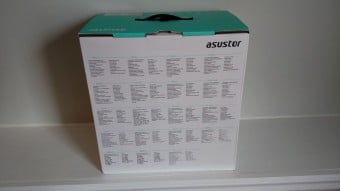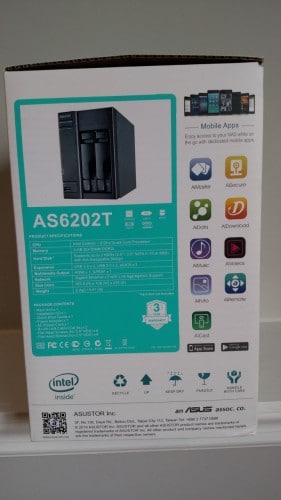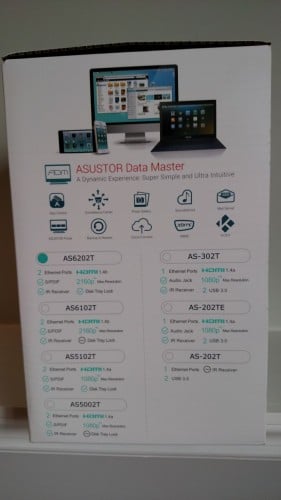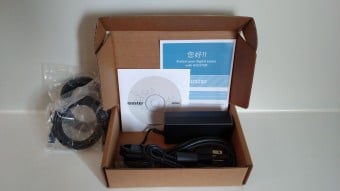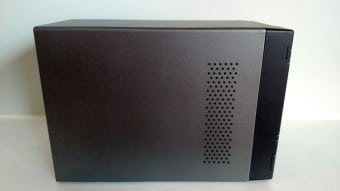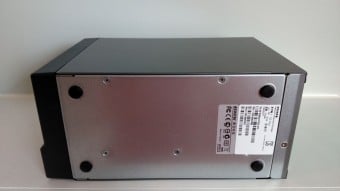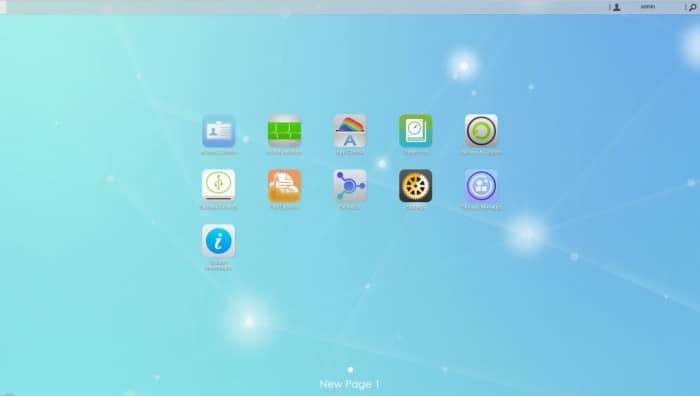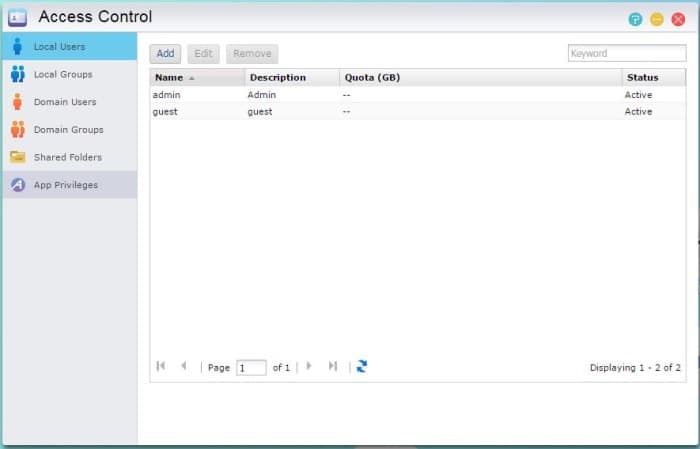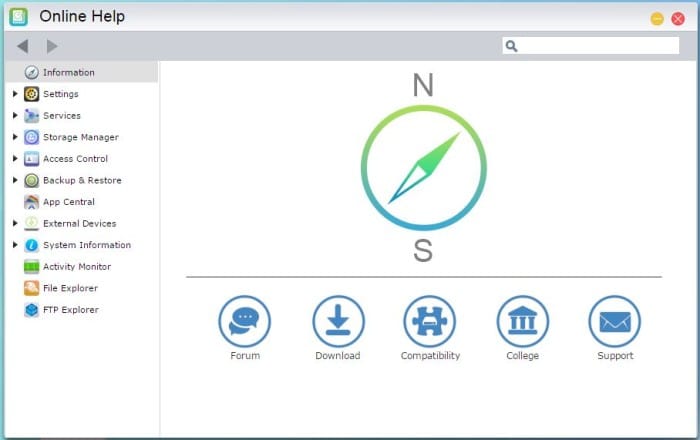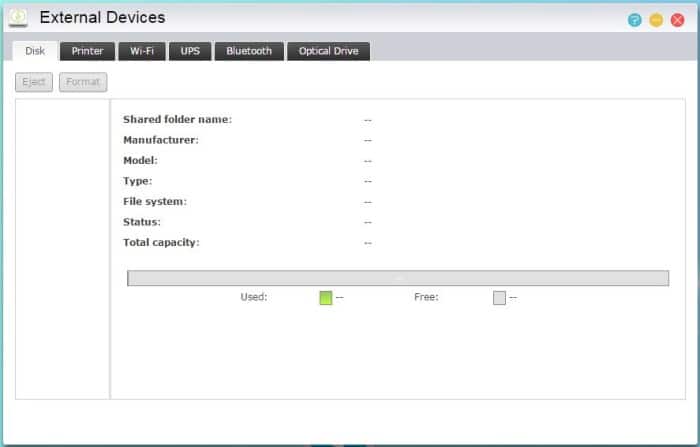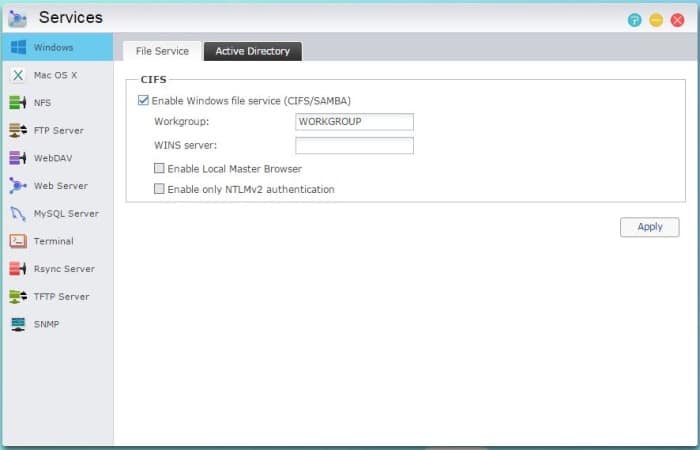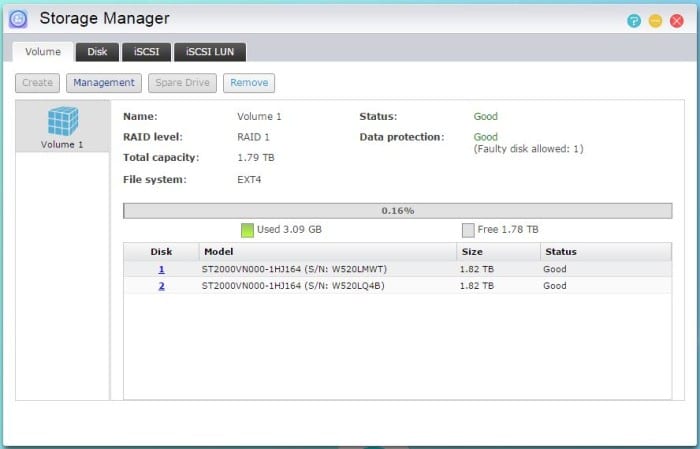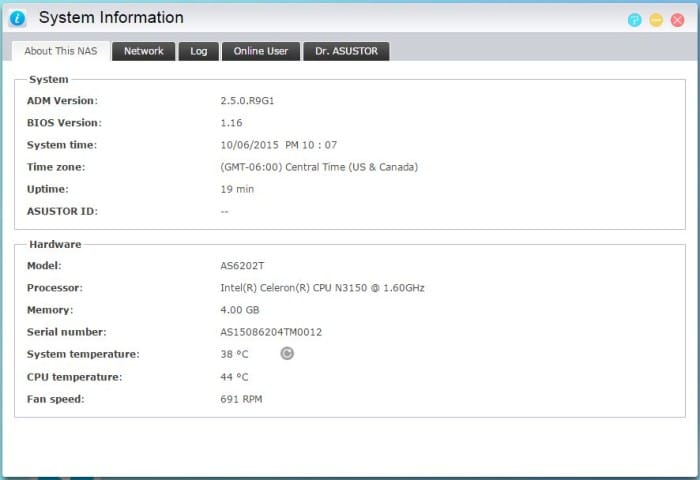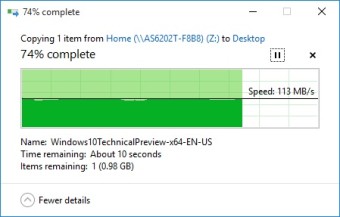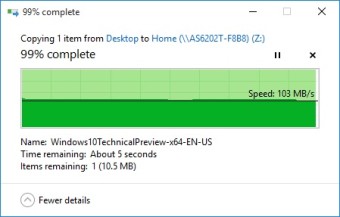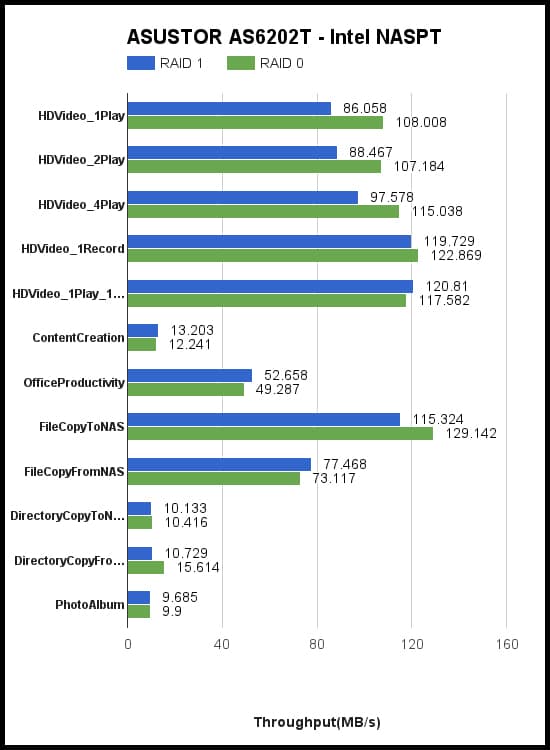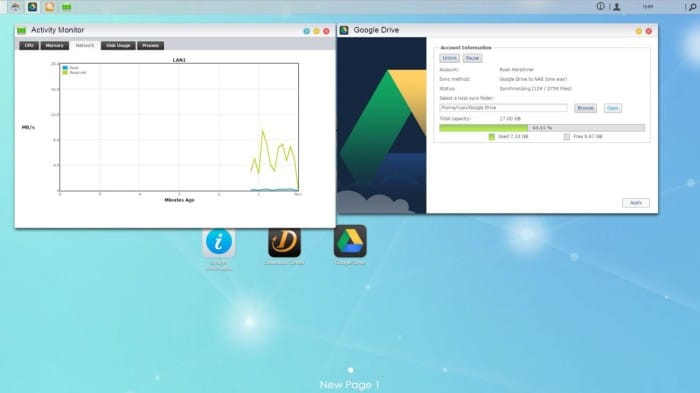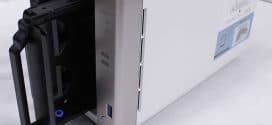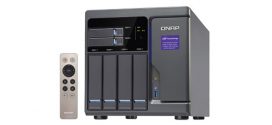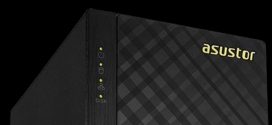INTRODUCTION
Breaking into the network attached storage (NAS) industry is no easy task these days, as competition for users’ data storage is fierce. Thankfully for ASUSTOR, they entered the industry in 2011. With the NAS industry growing by leaps and bounds, the products that a company must offer to potential customers must provide a plethora of additional services and features to stand out from the crowd. Gone are the days of NAS units only providing basic file sharing capabilities. We are now living in a world where NAS units often come with a robust user interface and the ability to run multiple advanced services like media streaming, file downloading, and even virtual machines.
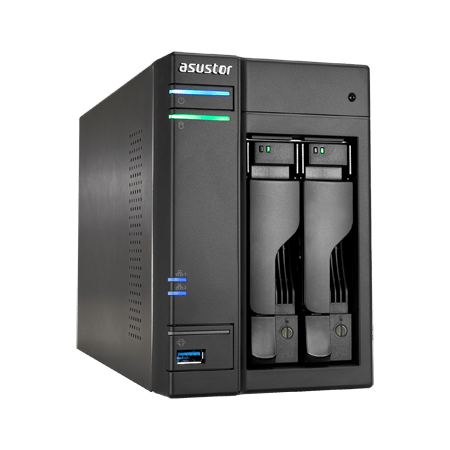
STANDOUT FEATURES
Looking to differentiate the AS6202T from the rest of the “power user” crowd, ASUSTOR took a few steps to make their way towards to top of the pile. Utilizing one of the latest Intel CPUs, along with the inclusion of dual-channel memory really helps this unit perform quite well.
- Intel Celeron N3150: The Celeron name may cause some users to shy away from the AS6202T at first, but let us remind you that these current-day chips are not the Celeron’s of days gone by. The N3150 is a quad-core chip running at a native 1.6 GHz, with the ability to boost to speeds of 2.08 GHz. While this chip doesn’t support HyperThreading, the four included cores should provide plenty of computing power for most users. The 14nm process allows the N3150 to have a TDP of just six Watts, ensuring that this NAS is a very power-efficient device.
- Dual-Channel Memory: Taking advantage of the N3150’s dual-channel memory support allows the AS6202T to perform on a level higher than systems that continue to utilize single-channel memory configurations.
- Hardware Encryption Engine: ASUSTOR has provided a built-in hardware encryption engine that can automatically encrypt all files as soon as they are stored on the AS6202T. While there is some hit to the write performance when enabled, the comfort in knowing that your files are safe should they fall into the wrong hands should more than make up for this.
SPECIFICATIONS
Below you will find the hardware specifications for the ASUSTOR AS6202T NAS. Of note is the Memory section listing the included 4GB of included RAM. This system supports up to 8GB of DDR3, which just so happens to be the maximum that the Intel Celeron N3150 supports.
- CPU: Intel Celeron N3150 1.6GHz Quad-Core (burst up to 2.08GHz) Processor
- AES-NI hardware encryption engine integrated
- Hardware transcoding engine supported format: H.264 (AVC), MPEG-4 Part 2, MPEG-2, VC-1
- Memory: 4GB SO-DIMM DDR3L (Expandable. Max 8GB)¹ Installation Guide
- HDD: 2.5″ / 3.5″ SATA II/ III or SSD x 2² Compatibility
- Maximum Internal Raw Capacity: 16 TB (8 TB HDD X 2, Capacity may vary by RAID types)
- Supports Hot Swappable Drives
- Expansion: USB 3.0 x 3, USB2.0 x 2, eSATA x 2
- Network: Gigabit Ethernet x 2
- Output: HDMI 1.4b x 1, S/PDIF x1
- System Fan: 70mm x 1
- Infrared Receiver
- Audio Output: S/PDIF
- Input Power Voltage: 100V to 240V AC
- Certification: FCC, CE, VCCI, BSMI, C-TICK
- Size: 163.5(H) x 108(W) x 230(D) mm
- Weight: 2 kg / 4.41 lbs
- Power Consumption:
- 16.6W (Operation);
- 9.5W (Disk Hibernation);
- .096W (Sleep Mode)
- Operation Temperature: 5°C~35°C (40°F~95°F)
- Humidity: 5% to 95% RH
CLOSER LOOK
Packaging
Nothing out of the ordinary here. ASUSTOR packaged the AS6202T in a standard cardboard box with marketing, features and specifications adorning all of the surfaces. A plastic carrying handle is provided for easy carrying. This type of packaging with the handle made us wonder just how many tech devices like this are actually purchased from a retail outlet. While this packaging would be great for that setting, we think most users probably order devices like this from an online store, and never have a need to carry the product around more than a few feet.
ASUSTOR took full advantage of each side of the packaging for the AS6202T to display the various features and functions that the unit provides. While this method is great for retail environments, we hate to see this great design work go to waste with online purchases.
Included with the AS6202T is an additional box containing an external AC power adapter and cord, two Cat5e network cables, an installation CD and Quick Start Guide, along with two types of screws that allow for the use of traditional hard drives or SSDs.
AS6202T
The AS6206T, being a 2-bay unit, really doesn’t take up much desk space. ASUSTOR has done a great job packing a ton of hardware into such a small space.
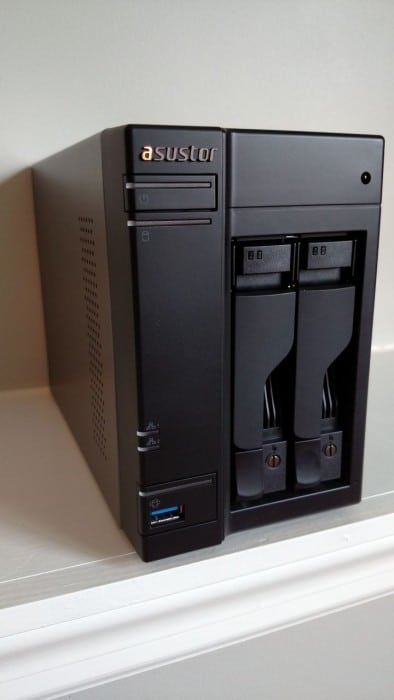
The rear of the AS6202T offers a wide selection of I/O ports in addition to the system cooling fan. Starting up top is an S/PDIF port for optical audio output. Just below is an HDMI 1.4b port that allows for connectivity to external displays. The AS6202T supports 1080p, as well as 4K, video output thanks to the Celeron N3150 chip nestled inside. Two eSATA ports, two USB 2.0 ports, and two USB 3.0 ports allow for a wide range of peripheral connectivity options. Dual 1Gbps network interfaces are provided, and can utilize link aggregation to provide both redundancy, as well as increased bandwidth throughput.
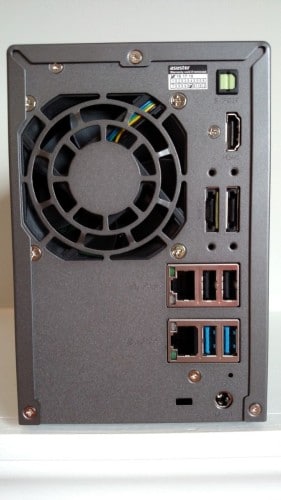
SYSTEM SETUP
ASUSTOR recently updated their native NAS OS, ASUSTOR Data Master (ADM) to version 2.5. This software update included quite a few additional features, which we will preview here.
- iSCSI LUN Snapshots: With the ability to provide almost instant LUN snapshots, ASUSTOR NAS devices running ADM 2.5 now offer the ability to recover and restore data if the need should arise to revert to another point in time.
- Internal Backup: By utilizing their MyArchive soltuion, ASUSTOR lets users designate a number of drive bays to be used for archival purposes. In the case of the AS6202T, since it is a 2-bay unit, one of the bays could be configured to serve as an archive, allowing you to swap out for another archive disk when needed.
- Network Recycle Bin: ASUSTOR updated this feature to allow for individual folders to have recycle bins, as opposed to the previous limit of only being available to storage volumes. Easy one-click functionality allows you to restore files to their original locations while maintaining permissions and properties.
- DataSync for Microsoft OneDrive: Synchronizing files with Microsoft’s OneDrive is now simple, thanks to this available app. Whether you want to sync files, or just push files one way or the other, this app helps you leverage Microsoft’s cloud storage.
- Syslog Server: Using the Syslog standards, ASUSTOR NAS devices can now function as a centralized server for monitoring devices, and allows for notifications for specified events.
For our testing purposes, we installed two Seagate NAS 2TB ST2000VN000s in the AS6202T. Once our drives were installed in the NAS, we fired it up and pointed our browser to the IP address that was given to the device by our router. While ASUSTOR does provide their Control Center application to both find and configure your NAS on your network, as well as manage it without accessing the ADM web console, we prefer to head straight to the ADM web console to get things done.
Once you reach the ADM web console for the first time, you will be greeted with a Welcome message and the ability to choose either a 1-Click Setup option or Custom Setup. After following the very basic Custom Setup guide that walks you through the basic setup detail such as the server name, a new admin password, network settings, etc., we were presented with a nice looking GUI interface for the AS6202T.
From here we were free to start exploring the multiple default options. The ADM environment also allows you to customize the login page and background of the GUI, which is a nice touch.
Access Control:
The Access Control application allows users to configure additional ADM accounts, all of which can be assigned quotas, be placed in groups, and configured much like most current-day NAS devices. Management of shared folders is also controlled in the Access Control portion of ADM 2.5, as is the ability to control access to the available apps.
Activity Monitor:
The Activity Monitor offers a look at the performance statistics of the AS6202T. Tabs for CPU, Memory and Network provide graphs that chart the last two minutes of statistics, while the Disk Usage tab provides a look at the overall disk utilization. The Process tab shows the status of multiple processes that the AS6202T utilizes to provide the services that it is configured for.
App Central:
App Central is the “app store” for ADM applications that can be installed on the AS6202T. ASUSTOR not only provides applications that have been written in-house, but also allows outside entities to create applications that run on their NAS devices. As you can see in the image above, multiple well known applications like Google Chrome and Google Drive, as well as Dropbox and OneDrive are available to make data synchronization and protection simple.
Online Help:
The Online Help application provides a launching point for finding information and help regarding the multiple features found on the AS6202T. ASUSTOR has really spent a lot of time polishing this application, and that shows in the amount of relevant information for all of the main features of this NAS.
Backup and Restore:
Backup and Restore offers multiple options for both local and remote backup and restoration functions. Being able to synchronize your NAS with another rsync compatible device is a great feature, and so is the FTP Backup availability. Internal Backup allows for the backing up of data to another local directory, while External Backup saves files to an external device attached locally to the AS6202T. The One Touch Backup option lets you configure how the USB button on the front of the NAS functions. You can disable the function all together, or have the NAS copy one way or another to an external drive. Cloud Backup is where Amazon S3 settings can be configured.
External Devices:
Taking advantage of the multiple connectivity options to connect external devices like printers and wireless adapters is all handled in the External Devices application. External storage devices can be configured, as well as an external optical drive. Adding a networked printer is also available from this menu, along with setting up both Bluetooth and Wi-Fi network adapters.
File Explorer:
The File Explorer application is home to a visual file browser that allows users to navigate the file structure of the AS6202T. Properties and permissions can be configured for the folders and files saved on the AS6202T, and this is also where the network recycle bins are made available.
Services:
Inside the Servies application is where protocols like CIFS and NFS can be configured. This application is also home to the configuration settings for the FTP and WebDAV services, which allow for easy remote access to the data stored on the AS6202T. The Web Server allows you to place files in the shared Web folder and then access those files on port 80, since the default port used for the ADM web console is 8000. These port settings are all configurable to suit your needs. Providing terminal access to the AS6202T is also available via the Services application, and SNMP monitoring can be configured here to allow for the capturing of SNMP statistics.
Settings:
The Settings application is where the meat and potatoes of the AS6202T’s operations are configured and managed. While many of these settings were configured during the initial setup wizard, these settings can be modified in the various menus provided in the Settings application. The VPN section allows you to configure a VPN to allow for remote access to your network. The Hardware section allows for some really cool customization options regarding the LED lights on the AS6202T, as well as energy settings, fan settings, and Wake-on-LAN.
Storage Manager:
The Storage Manager app is where the local storage can be configured for the various versions of RAID or JBOD. Since the AS6202T is just a 2-bay device, the only options available to us are RAID 0, 1 and JBOD. While we tested the AS6202T in both RAID 0 and RAID 1 settings, we would ultimately recommend utilizing RAID 1 in this unit, due to it only being a 2-bay device. The performance differences we saw during our testing just don’t justify the lack of protection that RAID 1 can provide. The Disk tab provides insight into the individual physical drives installed in the AS6202T, and offers S.M.A.R.T. information as well. The iSCSI and iSCSI LUN tabs are where iSCSI targets and LUNs can be created and managed.
System Information:
System Information is home to the device-specific information such as the ADM and BIOS versions running on the AS6202T, as well as the serial number and basic environmental statistics. The Network tab gives a general overview of the network settings for the NAS, and the Log tab details various events that have occurred on the NAS, such as the creation of folders, permission changes, system logins, and application installations. The Online User tab shows which users are currently accessing the NAS, while the Dr. ASUSTOR tab is home to diagnostic tools and overall health information for the AS6202T.
PERFORMANCE AND TESTING
When working with the AS6202T, we not only ran the Intel NAS Performance Toolkit, but we also performed multiple copy functions to and from the NAS. We also utilized some of the available applications to see how the could integrate with our existing experiences with them. Overall, the AS6202T performed very well in both RAID 0 and RAID 1 settings.
Testing out the throughput of the AS6202T showed us that it was capable of saturating the 1 Gbps on-board NIC during both read and write operations. The image on the left above shows a pretty steady 113 MB/s when downloading a 4GB ISO from the AS6202T to our test PC. The image on the right shows 103 MB/s when performing a copy of the 4GB ISO from our test PC to a shared folder on the AS6202T. For increased speeds, the AS6202T supports link aggregation, which allows you to take advantage of multiple NICs to multiply your available bandwidth.
The results from Intel’s NASPT application shown above give a good look at just how close in performance RAID 0 and RAID 1 were in the AS6202T. While the RAID 1 array did perform better overall, we would still recommend using RAID 0 in a 2-bay NAS like the AS6202T. Yes, you can, and should, back up your data to an alternate location, as RAID is not a backup solution. Even the small fault tolerance of a RAID 1 array is enough of a safety net for most users that it’s slightly worse performance, when compared to RAID 0’s performance, is worth the sacrifice.
Google Drive:
We utilize our Google Drive quite a bit, and the inclusion of a Google Drive application on the AS6202T was a delight. We chose to utilize the one-way synchronization method from our Google Drive to the NAS, as we are typically working remotely when utilizing our Google Drive. The setup was simple, and as soon as our account was configured on the NAS it began the task of downloading all of our files.
Plex Media Server:
The installation of Plex Media Server was as simple as any other application on the AS6202T. A quick search in App Central provided us with a simple “Install” button for Plex. Once we clicked “Install”, the AS6202T quickly downloaded and installed the server, placing an icon on our ADM desktop that launches the application. Once you click the application, it is immediately brought up in a new browser tab, and fully functional. We tested the streaming of a 1080p version of Big Buck Bunny to multiple devices including an ASUS Nexus 7 tablet, Motorola Droid Turbo, as well as our local browser window. Playback was smooth, and the AS6202T was still very responsive to other file transfers and services during the serving up of media content.
POWER CONSUMPTION AND NOISE
Power Consumption
With the power supply plugged into the wall and into the back of the AS6202T, the powered-off state of the device utilizes around 1.5 Watts. This is due to the external power brick being in an always powered-on state. Once the AS6202T was powered on and idling, it was utilizing 16.8 Watts. When the CPU was loaded with transcoding duties via Plex Media Server and a large file transfer taxing the hard drives, the wattage needed increased to 21.7 Watts. That’s not bad at all, considering our test machine idles at around 60 Watts.
Noise
Our testing environment places the AS6202T about four feet away from our ears, and with our desktop on, we were unable to hear the NAS at all. With only the AS6202T powered on and under load, there was just a slight hint of airflow noise through the chassis. Our noise testing found that the AS6202T was producing a level of about 30 dB.
CONCLUSION

Multiple connectivity options like USB 2.0, USB 3.0 and eSATA allow for the connection of external devices. The ability to customize just how the external connectivity operates is available with ADM, which allows you to set up the NAS to your specific needs. An HDMI connection allows the AS6202T to function at a media center in addition to a NAS, and the AS61 and AS62 models support 4k video playback.
The brain of the AS6202T is ASUSTOR’s ADM 2.5 environment. Setting up the AS6202T was a breeze thanks to the ADM environment, and configuring storage was just a few clicks away using the built-in applications. Once the NAS had a basic configuration, we loaded up a few of the available applications from App Central. The ability to synchronize the NAS with multiple cloud storage solutions will help you to establish a much-needed off-site backup for your critical data. Additional applications like multimedia servers and web servers allow you to turn the NAS into a multi-faceted appliance with just a few clicks. The ADM 2.5 environment is super clean, and very responsive, something you don’t always find when working with a NAS.
Powering the AS6202T is Intel’s latest Braswell CPU, the N3150, a quad-core 1.6GHz unit that sips on electricity. This CPU is powerful enough to not only serve up files, but to transcode media being streamed to devices across your network. Paired up with the N3150 is 4GB of dual-channel memory, which allows the AS6202T to offer smooth 4k video playback.
With a retail price right around $580 USD, this NAS does seem to be a bit pricey. But you must consider that outside of the traditional NAS duties, which the AS6202T handles quite well, this device can also function in many other aspects. The included HDMI output allows this NAS to become a media player with access to not just the data stored on the unit, but to online content as well. The multiple peripheral connections allow for printer sharing, and external storage connections. Add in all of the available applications in ADM, and you can really get your money’s worth out of the AS6202T. We can envision this unit serving multiple roles in a modern home environment. It serves up data and backs it up to the cloud automatically, it connects to the 60″ TV for movie night, it streams music and movies to the kids’ tablets, and it even provides home surveillance recording to keep things in check around the house. Toss in a 3-year warranty, and ASUSTOR is really pushing to get the AS61 and AS62 models into your home. After adding up all of the available features of the ASUSTOR AS6202T, we can really appreciate the value of this device.
Taking into account the efficient performance of the latest Intel silicon, paired with ASUSTOR’s robust ADM environment, it is easy to see why Bjorn3D is awarding the AS6202T the Seal of Approval Award.
| ASUSTOR AS6202T Pros | ASUSTOR AS6202T Cons |
|
|
 Bjorn3D.com Bjorn3d.com – Satisfying Your Daily Tech Cravings Since 1996
Bjorn3D.com Bjorn3d.com – Satisfying Your Daily Tech Cravings Since 1996


